Some of our content marketing gets real results.
Some of our content marketing …not so much.
This is obvious to anyone who has published anything anywhere. So naturally, marketing blogs are filled with advice on how to create high-performing content and how to measure performance.
But it’s less obvious that content performs in two different ways. Some content is good at winning clicks and attracting visitors. Some content is better at holding attention and engaging visitors.
If we put the two levels of performance (high/low) together with the two types of performance (traffic/engagement) …a matrix appears.
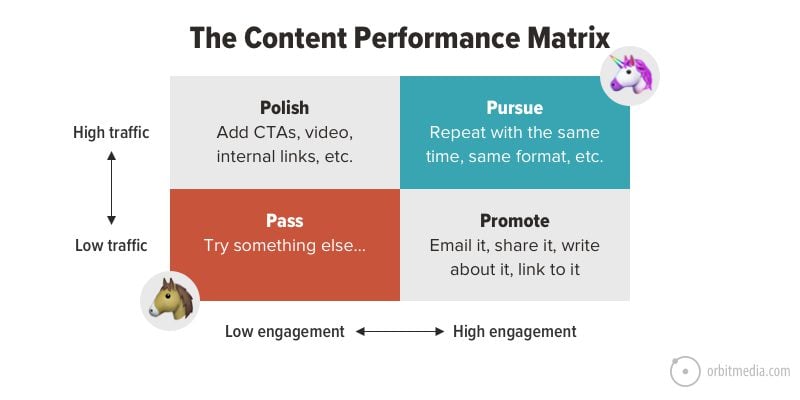
This content performance matrix shows the four outcomes from everything you’ve published. Not just winners and losers, but the ways in which they are winning or losing. Some content is strong in one way but weak in the other.
The insights can be powerful
- High traffic, high engagement…Pursue
These are the outperformers. You want to repeat these successes. - Low traffic, high engagement…Promote
These ones that people love, but almost no one sees them. - High traffic, low engagement …Polish
These bring loads of visitors who do nothing for your business. - Low traffic, low engagement…Pass
These had basically no impact whatsoever. Crickets.
Let’s look closely at each of these quadrants from our 2×2 performance matrix. We’ll learn how to find each and what to do with them, from insight to action.
Pursue: Your top performers
They say that everything in marketing is either a donkey or a unicorn. These are your unicorns. They are getting 10x results in both regards: traffic and engagement.
How to find your high traffic, high engagement content
Within a single report with a few customizations, they’ll jump out at you.
This is the Behavior > Site Content > All Pages report. Filter by blog post (it’s easy because they’re all in a common directory) and in the comparison view. We are comparing their bounce rate, which is a common engagement metric.
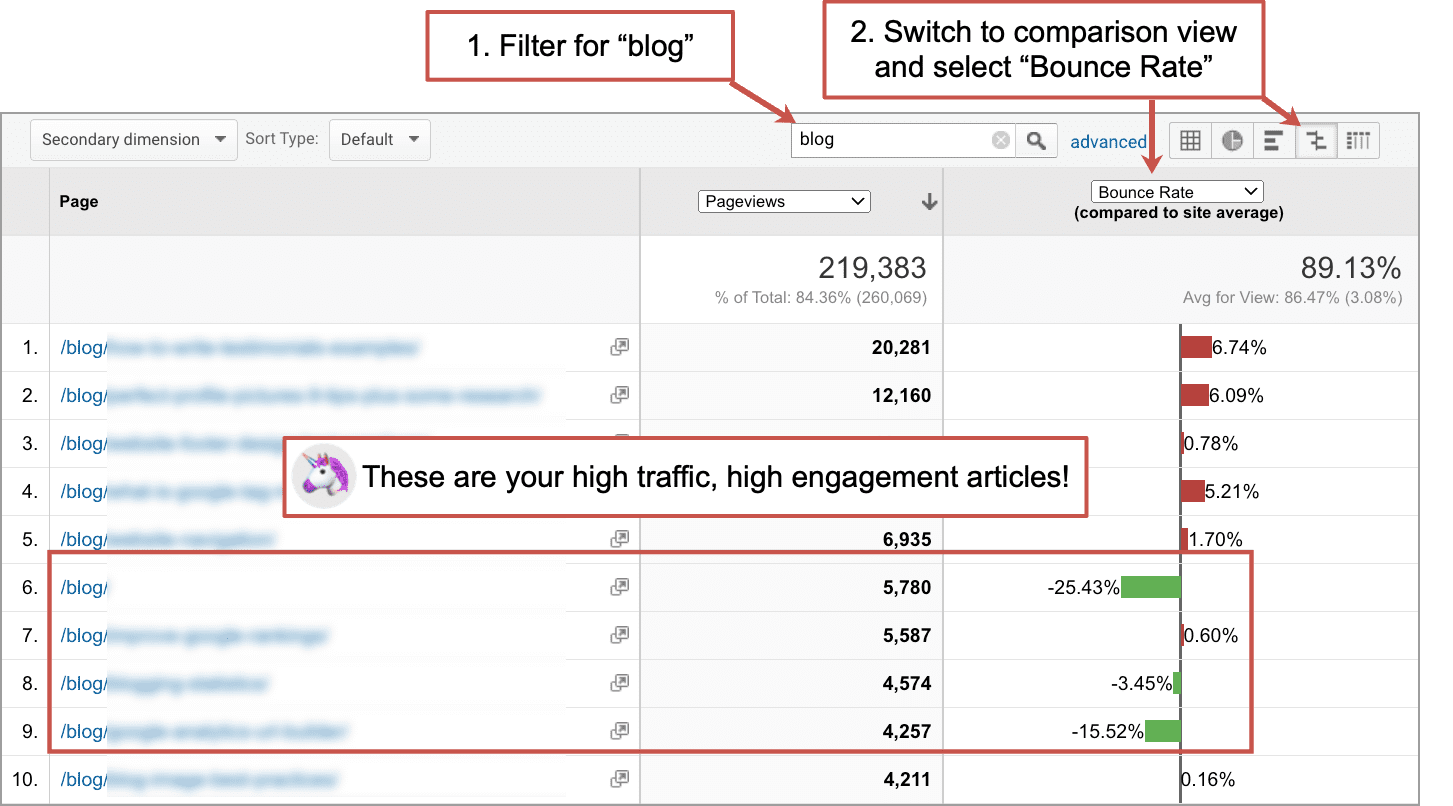
Are you using GA4 yet?
It’s the new version of Google Analytics and it’s …different. But the insights are the same. To find your top performers, customize the Engagement > Pages and screens report. Switch the primary dimension to “Page path + query string” (the GA4 term for URLs) and add “Engagement rate” to the report metrics.
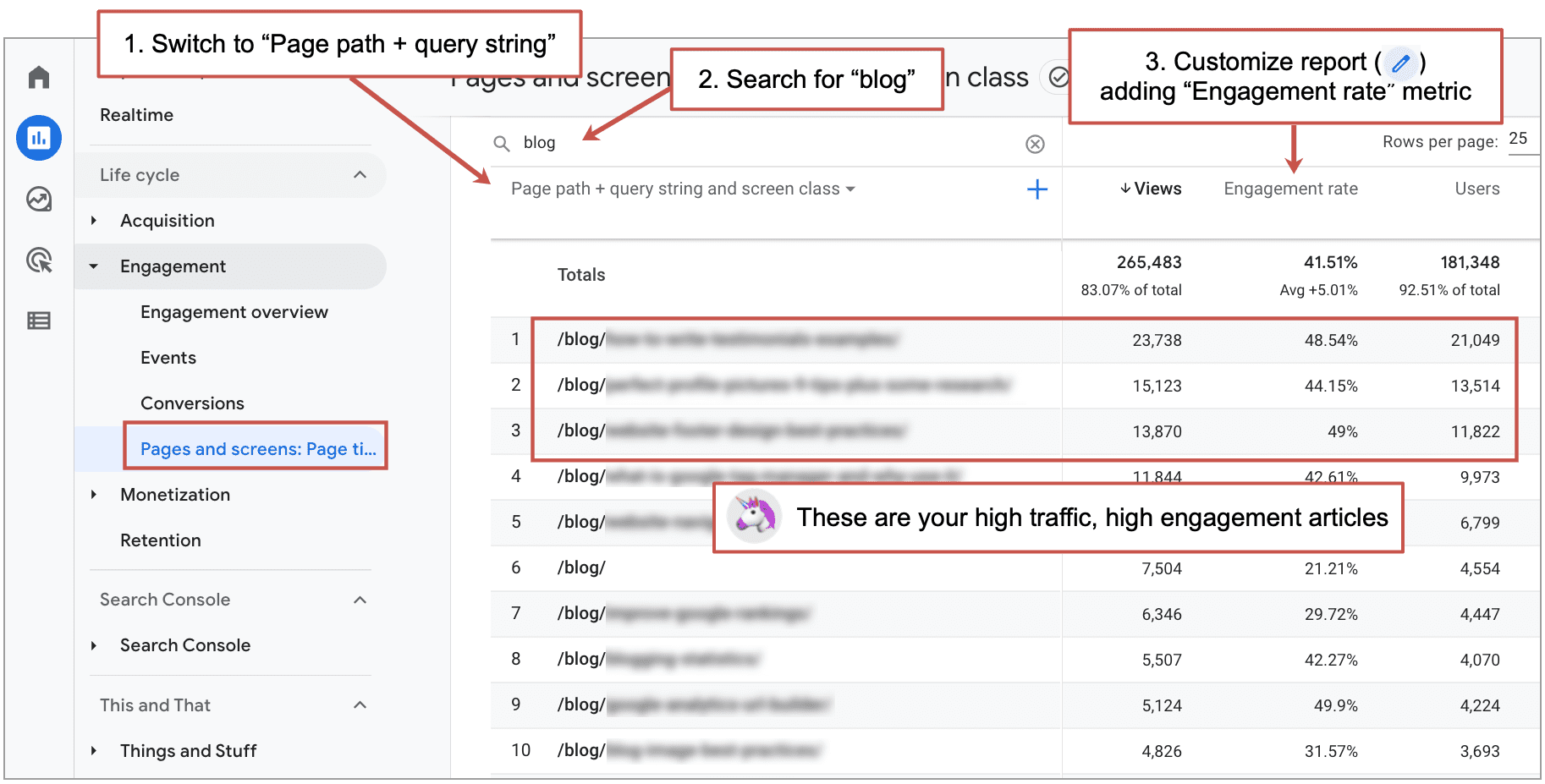
Actually, engagement rate is a better metric than bounce rate. The bounce rate metric has issues. But in GA4, an engaged visitor spent 10+ seconds on the page OR viewed more than one page OR triggered a conversion event.
What to do next with your top performers
Now that you’ve rounded up your unicorns, look at them closely. What do they have in common? Why did they work so well? Can those successes be repeated?
Find the pattern, then pursue it. Adapt your content strategy to prioritize that format, those topics, and those promotion tactics.
They’re likely driving 80% of the awareness and new subscribers. So your primary goal is to create more content that lands in this corner of the performance matrix. Even a few more can make a huge difference.
Example: Stan’s Lab Safety blog
Stan’s blog used to cover a lot of topics, but then he realized that the safety articles get the most traffic from organic search. And the safety checklists get the highest open rates in email. They also have 20% higher engagement rates on average.
So Stan commits to making one post per month a safety checklist. He changes his email sign-up CTAs to promise safety tips. He adds a popup offer for his most popular safety checklist.
 |
Steve Dolinsky, Food Reporter, NBC 5 Chicago and Founder Pizza City Fest Chicago“After 20 years of doing stories on thousands of restaurants in the region, we noticed pizza always got the most traction… So we’ve doubled down on that and started offering pizza tours. Now we’re launching an actual pizza festival. We are drilling down on our niche audience (not just food lovers and not just pizza tour customers but people actually interested in attending a festival about pizza) where we’re finding more engagement and more sales.“ |
Polish: Your high traffic, low engagement content
If “brand awareness” is the primary goal, these pages may be a big success. No one has ever clicked on an outdoor billboard, how are these posts any different? What’s wrong with 2,000 free visitors per month?
But if you’re looking for visitors who take meaningful actions, these visits are a frustration, especially when the article often has very little to do with the business.
A lot of websites have pages like this. Usually, it’s a “random ranker.”
It gets a ton of traffic from an irrelevant phrase, searched by purely information intent visitors. It’s a common story. They search… you rank… they click… they land… they linger… they leave.
How to find your high traffic, low engagement content
These ones often jump out at you from Analytics. In fact, you may see it every time you log in and it may be bothering you. It’s at the top of the Engagement > Site Content > All Pages report, month after month.
We see this in our Google Search Console reports all the time. That article from 2014 about online networking ranks for “how to start a conversation with a girl.” This is content marketing with zero impact on our business outcomes.
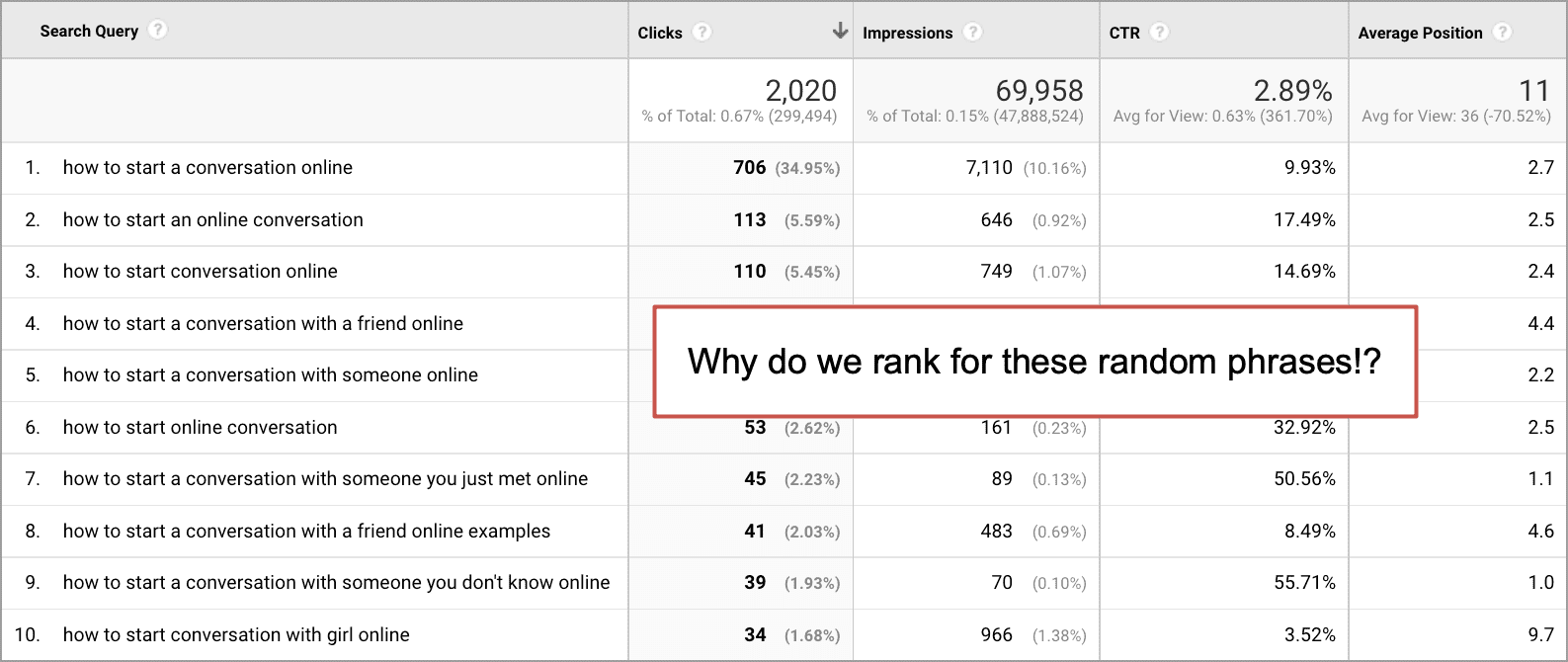
Random rankers are so common that I’m skeptical when people brag about their overall traffic levels. When someone tells me they get a million pageviews per year, I immediately wonder if half of those pageviews are for one URL that ranks for “why cats love lasers” or something similarly irrelevant.
What to do with that random article that gets a ton of irrelevant traffic?
Sadly, there are not many ways to squeeze more value from these pages. It’s often very difficult to convert blog traffic. The visitor’s intent is so low, their interest so fleeting, almost nothing will entice them to click on anything.
But it doesn’t hurt to try…
- Adding internal links to other articles
- Adding calls to action to visit product/service pages
- Adding calls to action to subscribe
- Adding a popup window with an offer for more content
- Adding Google AdSense to the page
- Adding a link to a friend’s website (maybe they’ll return the favor)
- Adding an embedded YouTube video
The general idea is to either improve the user experience or intercept the visitor and guide them toward a profitable action. Here is a tip from branding and engagement expert, Flavilla Fongang.
 |
Flavilla Fongang , The Brand Growth Strategist 3 Colours Rule“A great tip is to create a video summary which serves as a summary of the article/blog. Then use it at the start of the article/blog itself. We are attracted to content with faces so seeing a brand representative serve the content always increases engagement. Bonus: Your audience might not be on Tik Tok but the platform has great creative video tools for anyone to create engaging videos.“ |
If the page is so irritating that you want to remove it from your Analytics, you can filter them out with a segment, just as you would filter out spam traffic with a segment.
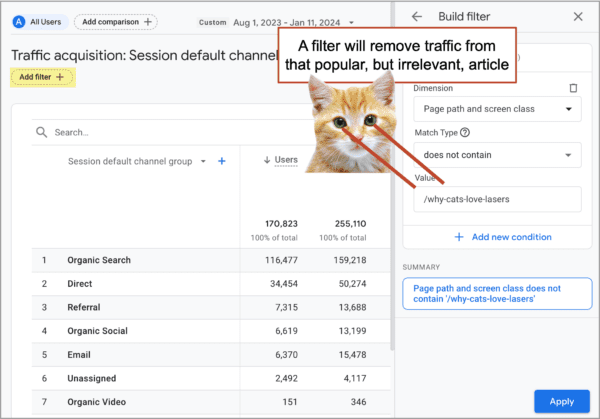
You can also delete the page I suppose. But why? It’s helping someone, right?
Example: Stan’s random ranker
Years ago, Stan wrote a blog post about laboratory signs, which told the history of the radiation symbol. It’s ranked high for “radiation symbol history” ever since, attracting 100+ visitors per day. These visitors never click on anything but the back button.
So Stan adds internal links from the article to his products, internal links to other articles and a popup to subscribe to his newsletter. He thinks about adding display ads to the page but ditches the idea.
Promote: Your low traffic, high engagement content
Readers loved it! …it just didn’t have many readers.
Marketing programs often have a lot in this quadrant of our content promotion matrix. Most websites have them: strong assets with weak visibility.
There are fundamentally two jobs in content marketing: creating high quality content is the first job. Promoting that content is the second job. The former is important; the later is critical. It’s impossible to overstate the importance of distribution and promotion.
Remember, the best content doesn’t win. The best promoted content wins.
How to find your low traffic, high engagement content
These definitely do not jump out at you from Analytics reports. They’re hiding. Probably, you’ve forgotten about them and how good they are. So think back. Scan through old articles. Ask around. Look for clues.
- Check your campaign reports
Find the emails that attracted low bounce rate (high engagement rate) visitors, even if traffic numbers were low. - Look for social posts with high engagement
It doesn’t matter who shared it. Maybe it wasn’t you. Sometimes, someone puts a different spin on a social post and gets a lot more traction.
Here’s a good example. I wrote an article and shared it. People liked it. Then Sarah Parker shared it and it went nuts. Literally thousands of likes and hundreds of comments. Clearly, I should work harder to promote this one from my own channels.
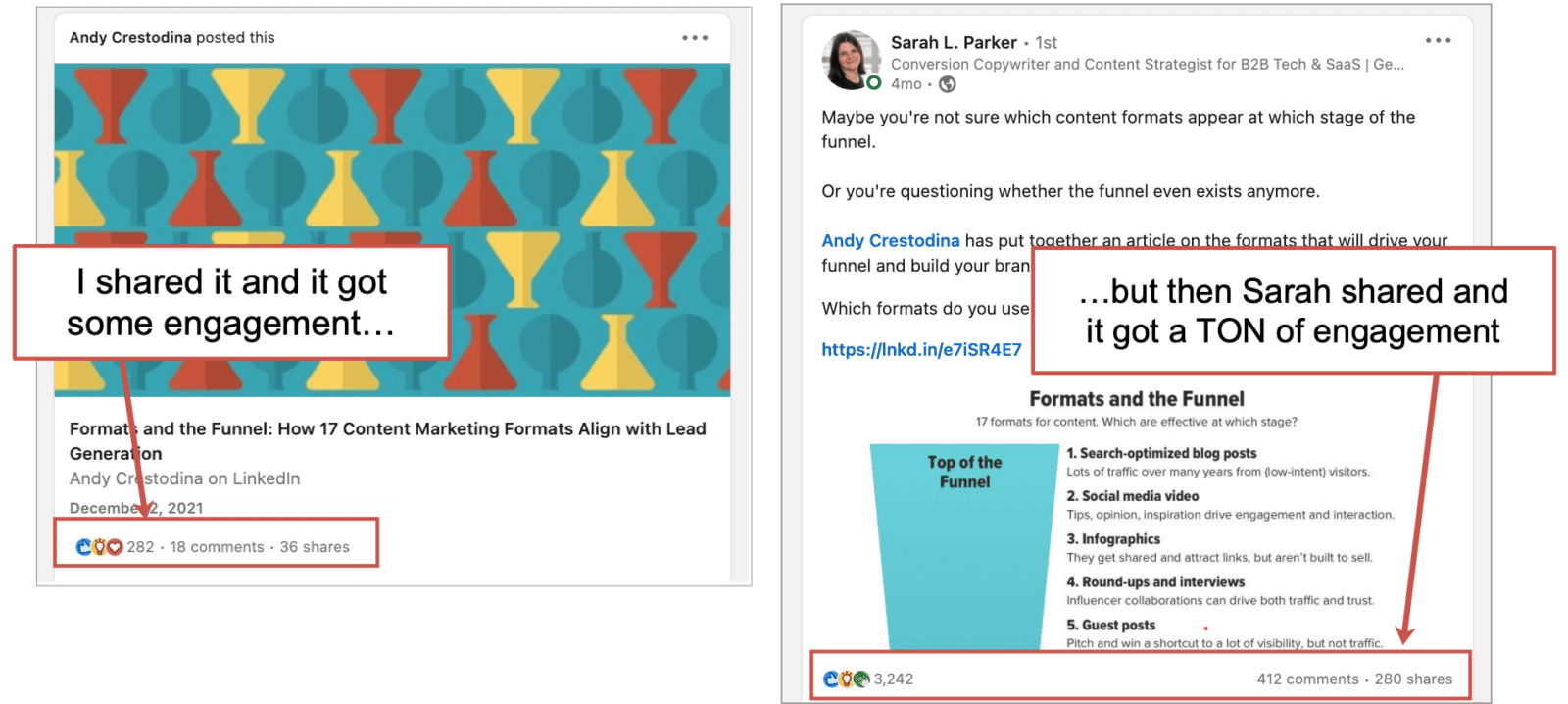
What to do with low traffic, high engagement content
Promoting an older, high-quality article will often drive better results than creating a new article.
- Share it on social media again …and again
It was a popular post at the time, but that was years ago. Even then, it’s likely that most of your followers didn’t see it. Remember organic reach in social media is low. Only 3% to 5% of your social followers will see any given post.Share it three times next week and three more times next month. - Send it as a newsletter again
If it’s been a year or more, your subscribers won’t notice that it’s the same article. Unless you have 100% open and CTRs, some of them didn’t see it the first time. And even if they all clicked it, what about your new subscribers?Give it a new subject line. Maybe freshen up the article. Then send. - Rewrite it for another website
Guest posts are the only posts that promote themselves. They are automatically in front of new readers. Rewrite it from a new angle, link back to the original and pitch it to a relevant blog. It will drive more awareness than actual traffic, but the link may be valuable. Tip! The “evil twin” is a rewritten version of an article that takes the negative angle. (example “best practices” becomes “biggest mistakes”) Editors love them so they’re easy to pitch. - Rewrite it with a stronger keyword focus
It’s possible that the article already ranks, but doesn’t yet rank high. If so, you have an awesome opportunity to create a lot of durable visibility. Carefully follow this step-by-step process for using Google Search Console to find those striking distance phrases. Sharpen the focus of the article to better target those phrases. - Syndicate it
If you simply copy and paste the article (or excerpts of it) into LinkedIn, it will reach a new audience. Add a call to action back to the original and you’ll see the impact in your Analytics. Medium works the same. You can also post sections of the article on Quora in response to relevant questions, and link these back to the original. - Put it on your homepage
Why not leverage the traffic you already have? If you feature content on your homepage, this is the perfect place to promote your strongest pieces, even if they aren’t new. Far better to use your homepage to manually curate your best, rather than just show the latest.
These are just a few items from our big list of 76 ways to promote content. Really, anything from that list will make it more visible.
Example: Stan’s “Layout for a Safe Lab” guide
It started as a little diagram, but Stan eventually made it into a set of detailed visuals, showing how to design a safe laboratory (where to put the eye wash station, fire extinguishers, etc.) It didn’t get much traffic, but it got shared a bunch and people still mention it to him.
In less time than it takes Stan to write a new article, he updates this old post. It was light on text, but still ranked sometimes for “safe laboratory design.” He adds 500 words of detailed explanation. He also rewrites it as “Dangerous Lab Layouts: 5 Serious Safety Mistakes” and pitches it as a guest post to a chemistry association he belongs to. They accept it and the link helps his rankings.
Pass: Your low traffic, low engagement content
Marketing is about making tough decisions. You have to know when to say when.
The fourth and final quadrant in our content matrix is for the lowest performers. They failed at both attracting and engaging visitors. These posts are like bad cheese on broken mouse traps.
How to find your low traffic, low engagement content
Usually you’ll spot them right after the (failed) attempt to promote them. You sent the email newsletter and then …crickets.
If you track email traffic by adding tracking codes using a URL builder (may I suggest this one?) you can confirm the dud in your campaign reports.
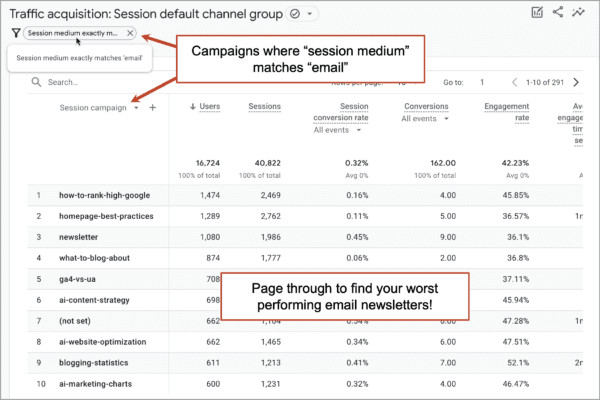
Or you shared it in a social stream and engagement was so low, you checked your internet connection.
So it flopped in email marketing or social media. But be careful drawing quick conclusions from a single promotion channel. That post that failed in one channel may do well in another. Some topics may be terrible for social, but great for search. Others, vice versa.
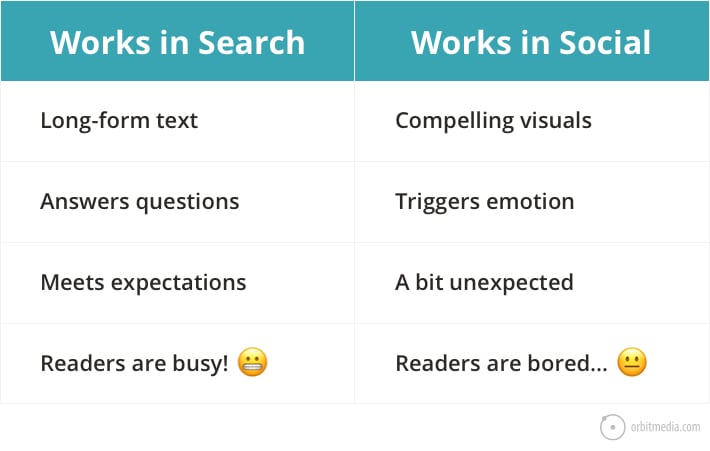
But we’re also talking about the content that fails to impress after the click. These articles have high bounce rates, low engagement rates, low average time on page, etc.
Why? Usually it’s because they’re undifferentiated. They’re standard advice with a boring headline. Nothing new. No visuals, or one stock image. No contributor quotes. The depth is shallow. The assertions are weak.
What to do with your lowest-performing content
Nothing.
I have close friends who disagree with me on this. But I recommend paying no attention and spending no time on these articles. Move on.
There are digital marketers who believe that pruning content is good for your search rankings. But I’ve seen no evidence of this. The few case studies that show results from this tactic are for very large websites with tens of thousands of URLs.
 |
Chris Carr Farotech“The true art of content refinement is to have the courage to actually pass on the content you actually believe in. Marketers who say YES to everything often pump out a lot of ‘meh’ content that doesn’t convert, doesn’t drive inbound links, and often leaves you feeling deflated. Instead, remind yourself that every time you say NO to poor performing content that you might be emotionally invested in, you are saying YES to adding time and energy to good content that has the potential to be great.“ |
Example: Stan’s product reviews
Back when Stan didn’t know what to write about, he decided to write a weekly review of a product he’s using. Each review would take a few hours, and they were posted on his how-to lab safety blog with everything else.
But they never did well. His subscribers signed up for safety tips, not product reviews, so email open rates were always low. And anyone looking for a product review could find hundreds of them on the big retail sites. After diligently following his own content strategy, he finally looked at the data and realized, these posts were a cost with no benefit. He gave up and put the time toward a monthly YouTube video.
The data-driven next steps for everything you’ve ever published
That’s our answer to the question: What is a content performance matrix? It’s simply a way to evaluate the effectiveness of your existing content and guide decisions on marketing activities to do next. It’s a framework for measurement and a guide for action.
Larry Kim once said that everything you’ve ever published is either a donkey or a unicorn. Here we’ve just added another dimension to that statement. Because actually, everything is either a donkey or unicorn in two distinct ways: traffic and engagement.
I invite you to extend this analysis into all areas of your content marketing. Ask yourself: “Can I find the top performers in each of these aspects of your marketing?”
- Topics
- Formats
- Channels
- Length
- Timing
- Frequency
- Influencer collaborations
- Email subject lines
- Calls to action
Make marketing a habit, but only after you know that it’s an effective habit.




